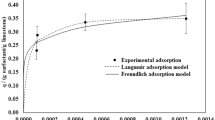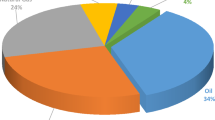Abstract
Different analytical methods were utilized to investigate the mechanisms for wettability alteration of oil-wet sandstone surfaces induced by different surfactants and the effect of reservoir wettability on oil recovery. The cationic surfactant cetyltrimethylammonium bromide (CTAB) is more effective than the nonionic surfactant octylphenol ethoxylate (TX-100) and the anionic surfactant sodium laureth sulfate (POE(1)) in altering the wettability of oil-wet sandstone surfaces. The cationic surfactant CTAB was able to desorb negatively charged carboxylates of crude oil from the solid surface in an irreversible way by the formation of ion pairs. For the nonionic surfactant TX-100 and the anionic surfactant POE(1), the wettability of oil-wet sandstone surfaces is changed by the adsorption of surfactants on the solid surface. The different surfactants were added into water to vary the core surface wettability, while maintaining a constant interfacial tension. The more water-wet core showed a higher oil recovery by spontaneous imbibition. The neutral wetting micromodel showed the highest oil recovery by waterflooding and the oil-wet model showed the maximum residual oil saturation among all the models.










Similar content being viewed by others
Abbreviations
- k :
-
Rock permeability (10−3 μm2)
- S oi :
-
Initial oil saturation (fraction, %)
- wt %:
-
Weight %
- CMC:
-
Critical micelle concentration
- IFT:
-
Interfacial tension (mN/m)
- OOIP:
-
Original oil in place
- PV:
-
Pore volume (mL)
References
Kennedy HT, Burja EO, Boykin RS (1955) An investigation of the effects of wettability on oil recovery by water flooding. J Phys Chem 59:867–869. doi:10.1021/j150531a015
Wang Y, Xu H, Yu W, Bai B, Song X, Zhang J (2011) Surfactant induced reservoir wettability alteration: recent theoretical and experimental advances in enhanced oil recovery. Pet Sci 8:463–476. doi:10.1007/s12182-011-0164-7
Zhou X, Morrow N, Ma S (2000) Interrelationship of wettability, initial water saturation, aging time, and oil recovery by spontaneous imbibition and waterflooding. SPE J 5:199–207
Morrow NR (1990) Wettability and its effect on oil recovery. J Pet Technol 42:1476–1484
Anderson WG (1987) Wettability literature survey-part 6: the effects of wettability on waterflooding. J Pet Technol 39:1605–1622
Jackson MD, Valvatne PH, Blunt MJ (2005) Prediction of wettability variation within an oil/water transition zone and its impact on production. SPE J 10:185–195
Han D, Yuan H, Wang H, Dong F (2006) The effect of wettability on oil recovery by alkaline/surfactant/polymer flooding. In: SPE Annual Technical Conference and Exhibition. Society of Petroleum Engineers. 10.2118/102564-MS
Tweheyo M, Holt T, Torsæter O (1999) An experimental study of the relationship between wettability and oil production characteristics. J Pet Sci Eng 24:179–188. doi:10.1016/S0920-4105(99)00041-8
Graue A, Bognø T, Baldwin B, Spinler E (2001) Wettability effects on oil-recovery mechanisms in fractured reservoirs. SPE Reserv Eval Eng 4:455–466
Jarrahian K, Seiedi O, Sheykhan M, Sefti MV, Ayatollahi S (2012) Wettability alteration of carbonate rocks by surfactants: a mechanistic study. Coll Surf A 410:1–10. doi:10.1016/j.colsurfa.2012.06.007
Salehi M, Johnson SJ, Liang JT (2008) Mechanistic study of wettability alteration using surfactants with applications in naturally fractured reservoirs. Langmuir 24:14099–14107. doi:10.1021/la802464u
Standnes DC, Austad T (2000) Wettability alteration in chalk: 2. Mechanism for wettability alteration from oil-wet to water-wet using surfactants. J Pet Sci Eng 28:123–143. doi:10.1016/S0920-4105(00)00084-X
Gupta R, Mohanty K (2011) Wettability alteration mechanism for oil recovery from fractured carbonate rocks. Transp Porous Media 87:635–652. doi:10.1007/s11242-010-9706-5
Seiedi O, Rahbar M, Nabipour M, Emadi MA, Ghatee MH, Ayatollahi S (2010) Atomic force microscopy (AFM) investigation on the surfactant wettability alteration mechanism of aged mica mineral surfaces. Energy Fuel 25:183–188. doi:10.1021/ef100699t
Golabi E, Azad FS, Branch O (2012) Experimental study of wettability alteration of limestone rock from oil-wet to water-wet using various surfactants. In: SPE Heavy Oil Conference. Society of Petroleum Engineers, pp 12–14
Jadhunandan P, Morrow N (1995) Effect of wettability on waterflood recovery for crude-oil/brine/rock systems. SPE Reserv Eng 10:40–46
Morrow NR, Lim HT, Ward JS (1986) Effect of crude-oil-induced wettability changes on oil recovery. SPE Form Eval 1:89–103
Biswas S, Dubreil L, Marion D (2001) Interfacial behavior of wheat puroindolines: study of adsorption at the air–water interface from surface tension measurement using Wilhelmy plate method. J Colloid Interface Sci 244:245–253. doi:10.1006/jcis.2001.7940
Standnes DC, Nogaret LA, Chen HL, Austad T (2002) An evaluation of spontaneous imbibition of water into oil-wet carbonate reservoir cores using a nonionic and a cationic surfactant. Energy Fuel 16:1557–1564. doi:10.1021/ef0201127
Qi Z, Wang Y, He H, Li D, Xu X (2013) Wettability alteration of the quartz surface in the presence of metal cations. Energy Fuel 27:7354–7359. doi:10.1021/ef401928c
Du W, Wu Y (2007) Comparison of hypsometry and goniometry in contact angle measurement. J Text Res 28:29–32
Strand S, Standnes DC, Austad T (2003) Spontaneous imbibition of aqueous surfactant solutions into neutral to oil-wet carbonate cores: effects of brine salinity and composition. Energy Fuel 17:1133–1144. doi:10.1021/ef030051s
Donaldson EC, Thomas RD (1971) Microscopic observations of oil displacement in water-wet and oil-wet systems. In: Fall Meeting of the Society of Petroleum Engineers of AIME. Society of Petroleum Engineers. 10.2118/3555-MS
Jamaloei BY, Kharrat R (2010) Analysis of microscopic displacement mechanisms of dilute surfactant flooding in oil-wet and water-wet porous media. Transp Porous Media 81:1–19. doi:10.1007/s11242-009-9382-5
Robin M (2001) Interfacial phenomena: reservoir wettability in oil recovery. Oil Gas Sci Technol 56:55–62. doi:10.2516/ogst:2001007
Polson EJ, Buckman JO, Bowen D, Todd AC, Gow MM, Cuthbert SJ (2010) An environmental-scanning-electron-microscope investigation into the effect of biofilm on the wettability of quartz. SPE J 15:223–227
Robin M, Combes R, Rosenberg E (1999) Cryo-SEM and ESEM: new techniques to investigate phase interactions within reservoir rocks. In: SPE annual technical conference. Society of Petroleum Engineers. 10.2118/56829-MS
Combes R, Robin M, Blavier G, Aïdan M, Degreve F (1998) Visualization of imbibition in porous media by environmental scanning electron microscopy: application to reservoir rocks. J Pet Sci Eng 20:133–139. doi:10.1016/S0920-4105(98)00012-6
Robin M, Rosenberg E, Fassi Fihri O (1995) Wettability studies at the pore level: a new approach by use of Cryo-SEM. SPE Formation Eval 10:22–29
Hou B, Wang Y, Huang Y (2015) Mechanistic study of wettability alteration of oil-wet sandstone surface using different surfactants. Appl Surf Sci 330:56–64. doi:10.1016/j.apsusc.2014.12.185
Buckley J, Liu Y, Monsterleet S (1998) Mechanisms of wetting alteration by crude oils. SPE J 3:54–61
Acknowledgments
Financial support by the Program for Changjiang Scholars and Innovative Research Team in University (IRT1294) and the Fundamental Research Funds for the Central Universities (13CX05019A and 15CX02006A) are all gratefully acknowledged.
Author information
Authors and Affiliations
Corresponding author
About this article
Cite this article
Hou, B., Wang, Y., Cao, X. et al. Surfactant-Induced Wettability Alteration of Oil-Wet Sandstone Surface: Mechanisms and Its Effect on Oil Recovery. J Surfact Deterg 19, 315–324 (2016). https://doi.org/10.1007/s11743-015-1770-y
Received:
Accepted:
Published:
Issue Date:
DOI: https://doi.org/10.1007/s11743-015-1770-y




